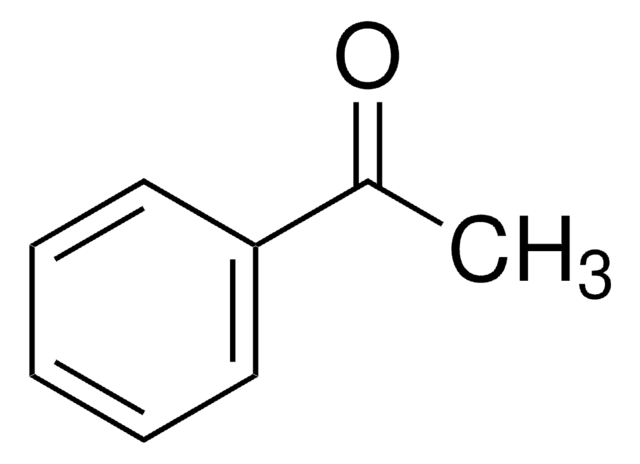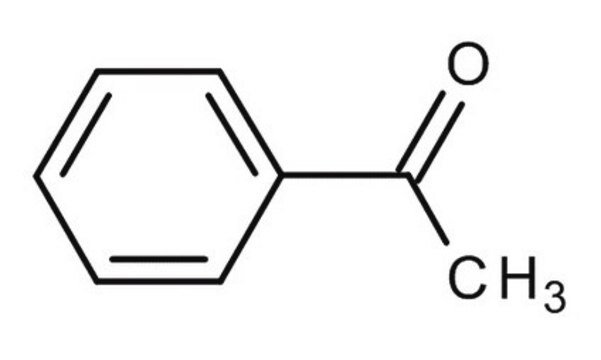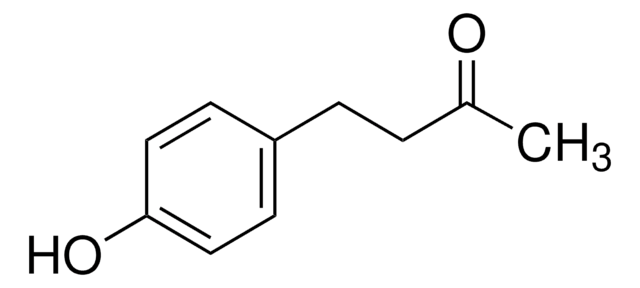W267007
p-Anisaldehyde
≥97.5%, FCC, FG
Sinonimo/i:
4-Methoxybenzaldehyde, Aubépine
About This Item
Prodotti consigliati
Origine biologica
synthetic
Livello qualitativo
Grado
FG
Fragrance grade
Halal
Kosher
agenzia
follows IFRA guidelines
meets purity specifications of JECFA
Conformità normativa
EU Regulation 1223/2009
EU Regulation 1334/2008 & 872/2012
FCC
FDA 21 CFR 172.515
Densità del vapore
4.7 (vs air)
Saggio
≥97.5%
Forma fisica
liquid
Composizione
contains IFRA restricted p-Anisaldehyde
Indice di rifrazione
n20/D 1.573 (lit.)
P. eboll.
248 °C (lit.)
Punto di fusione
−1 °C (lit.)
Densità
1.119 g/mL at 25 °C (lit.)
applicazioni
flavors and fragrances
Documentazione
see Safety & Documentation for available documents
Allergene alimentare
no known allergens
Allergene in fragranze
no known allergens
Organolettico
anise; cherry; creamy; floral; balsamic; sweet; vanilla
Stringa SMILE
[H]C(=O)c1ccc(OC)cc1
InChI
1S/C8H8O2/c1-10-8-4-2-7(6-9)3-5-8/h2-6H,1H3
ZRSNZINYAWTAHE-UHFFFAOYSA-N
Informazioni sul gene
human ... CYP1A2(1544)
Cerchi prodotti simili? Visita Guida al confronto tra prodotti
Categorie correlate
Applicazioni
- Aryl-alcohol oxidase involved in lignin degradation: a mechanistic study based on steady and pre-steady state kinetics and primary and solvent isotope effects with two alcohol substrates.: The study focuses on the mechanistic understanding of aryl-alcohol oxidase in lignin degradation, utilizing p-Anisaldehyde as a model substrate to investigate enzyme kinetics and isotope effects. (Ferreira et al., 2009).
Azioni biochim/fisiol
Altre note
Avvertenze
Warning
Indicazioni di pericolo
Consigli di prudenza
Classi di pericolo
Aquatic Chronic 3 - Repr. 2
Codice della classe di stoccaggio
10 - Combustible liquids
Classe di pericolosità dell'acqua (WGK)
WGK 1
Punto d’infiammabilità (°F)
240.8 °F - closed cup
Punto d’infiammabilità (°C)
116 °C - closed cup
Scegli una delle versioni più recenti:
Possiedi già questo prodotto?
I documenti relativi ai prodotti acquistati recentemente sono disponibili nell’Archivio dei documenti.
I clienti hanno visto anche
Il team dei nostri ricercatori vanta grande esperienza in tutte le aree della ricerca quali Life Science, scienza dei materiali, sintesi chimica, cromatografia, discipline analitiche, ecc..
Contatta l'Assistenza Tecnica.













